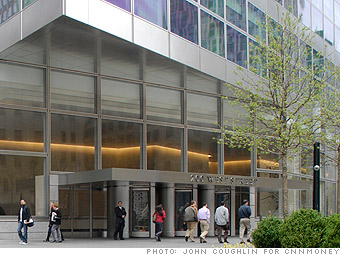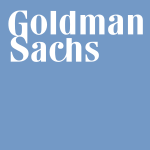
百大雇主品牌 – 93 – Goldman Sachs Group – New York US
Top company by employee – 93 – Goldman Sachs Group – New York US
13326 employees
www.gs.com
Industry: Financial Services & Insurance – Banking/Credit Services
Ownership: Publicly quoted/held
State: New York
Rank: 93
Previous rank: 33
2011 revenue ($ millions): $28,811
What makes it so great?
Most employees at the investment bank are unwavering in praise, thanks in large part to a reported average annual compensation of more than $300,000.
Headquarters:
New York, NY
Website: www.gs.com
| Type | Public |
|---|---|
| Traded as | NYSE: GS Dow Jones Industrial Average Component S&P 500 Component |
| Industry | Banking, Financial Services |
| Founded | 1869 |
| Founder(s) | Marcus Goldman, Samuel Sachs |
| Headquarters | 200 West Street, New York, New York, U.S. |
| Area served | Worldwide |
| Key people | Lloyd C. Blankfein (Chairman & CEO) |
| Products | Asset management, commercial banking, commodities,investment banking, investment management, mutual funds,prime brokerage |
| Revenue | |
| Operating income | |
| Net income | |
| Total assets | |
| Total equity | |
| Employees | 31,700 (2013)[2] |
| Website | GoldmanSachs.com |
The Goldman Sachs Group, Inc. is an American multinational investment banking firm that engages in global investment banking,securities, investment management, and other financial services primarily with institutional clients.
Goldman Sachs was founded in 1869 and is headquartered at 200 West Street in the Lower Manhattan area of New York City, with additional offices in international financial centers. The firm provides mergers and acquisitions advice, underwriting services, asset management, and prime brokerage to its clients, which include corporations, governments and individuals. The firm also engages inmarket making and private equity deals, and is a primary dealer in the United States Treasury security market. It is recognized as one of the premier investment banks in the world,[3][4] but has sparked a great deal of controversy over its alleged improper practices, especially since the 2007–2012 global financial crisis.
Former Goldman executives who moved on to government positions include: Robert Rubin and Henry Paulson who served as United States Secretary of the Treasury under Presidents Bill Clinton and George W. Bush, respectively; Mario Draghi, President of theEuropean Central Bank; Mark Carney, Governor of the Bank of Canada 2008–13 and Governor of the Bank of England from July 2013.
History[edit]
1869–1930[edit]
Goldman Sachs was founded in New York in 1869 by the German-born Marcus Goldman.[5][6] In 1882, Goldman’s son-in-law Samuel Sachs joined the firm.[7] In 1885, Goldman took his son Henry and his son-in-law Ludwig Dreyfuss into the business and the firm adopted its present name, Goldman Sachs & Co.[8] The company made a name for itself pioneering the use of commercial paper for entrepreneurs and was invited to join the New York Stock Exchange (NYSE) in 1896.
In the early 20th century, Goldman was a player in establishing the initial public offering (IPO) market. It managed one of the largest IPOs to date, that of Sears, Roebuck and Company in 1906. It also became one of the first companies to heavily recruit those with MBA degrees from leading business schools, a practice that still continues today.[citation needed]
On December 4, 1928, it launched the Goldman Sachs Trading Corp. a closed-end fund. The fund failed as a result of the Stock Market Crash of 1929, hurting the firm’s reputation for several years afterward.[9] Of this case and others like Blue Ridge Corporation[10] and Shenandoah Corporation[11] John Kenneth Galbraith wrote: “The Autumn of 1929 was, perhaps, the first occasion when men succeeded on a large scale in swindling themselves.”[12]
1930–1980[edit]
In 1930, Sidney Weinberg assumed the role of senior partner and shifted Goldman’s focus away from trading and towards investment banking. It was Weinberg’s actions that helped to restore some of Goldman’s tarnished reputation. On the back of Weinberg, Goldman was lead advisor on the Ford Motor Company’s IPO in 1956, which at the time was a major coup on Wall Street. Under Weinberg’s reign the firm also started an investment research division and a municipal bond department. It also was at this time that the firm became an early innovator in risk arbitrage.
Gus Levy joined the firm in the 1950s as a securities trader, which started a trend at Goldman where there would be two powers generally vying for supremacy, one from investment banking and one from securities trading. For most of the 1950s and 1960s, this would be Weinberg and Levy. Levy was a pioneer in block trading and the firm established this trend under his guidance. Due to Weinberg’s heavy influence at the firm, it formed an investment banking division in 1956 in an attempt to spread around influence and not focus it all on Weinberg.
In 1969, Levy took over as Senior Partner from Weinberg, and built Goldman’s trading franchise once again. It is Levy who is credited with Goldman’s famous philosophy of being “long-term greedy”, which implied that as long as money is made over the long term, trading losses in the short term were not to be worried about. At the same time, partners reinvested almost all of their earnings in the firm, so the focus was always on the future.[13] That same year, Weinberg retired from the firm.
Another financial crisis for the firm occurred in 1970, when the Penn Central Transportation Company went bankrupt with over $80 million in commercial paper outstanding, most of it issued through Goldman Sachs. The bankruptcy was large, and the resulting lawsuits, notably by the SEC, threatened the partnership capital, life and reputation of the firm.[14] It was this bankruptcy that resulted in credit ratings being created for every issuer of commercial paper today by several credit rating services.[15]
During the 1970s, the firm also expanded in several ways. Under the direction of Senior Partner Stanley R. Miller, it opened its first international office in London in 1970, and created a private wealth division along with a fixed income division in 1972. It also pioneered the “white knight” strategy in 1974 during its attempts to defend Electric Storage Battery against a hostile takeover bid from International Nickel and Goldman’s rival Morgan Stanley.[16] This action would boost the firm’s reputation as an investment advisorbecause it pledged to no longer participate in hostile takeovers.
John L. Weinberg (the son of Sidney Weinberg), and John C. Whitehead assumed roles of co-senior partners in 1976, once again emphasizing the co-leadership at the firm. One of their initiatives[citation needed] was the establishment of 14 business principles that the firm still claims to apply.[17]
1980–1999[edit]
On November 16, 1981, the firm acquired J. Aron & Company, a commodities trading firm which merged with the Fixed Income division to become known as Fixed Income, Currencies, and Commodities. J. Aron was a player in the coffee and gold markets, and the current CEO of Goldman, Lloyd Blankfein, joined the firm as a result of this merger. In 1985 it underwrote the public offering of the Real Estate Investment Trust that owned Rockefeller Center, then the largest REIT offering in history. In accordance with the beginning of the dissolution of the Soviet Union, the firm also became involved in facilitating the global privatization movement by advising companies that were spinning off from their parent governments.
In 1986, the firm formed Goldman Sachs Asset Management, which manages the majority of its mutual funds and hedge funds today. In the same year, the firm also underwrote the IPO of Microsoft, advised General Electric on its acquisition of RCA and joined the London and Tokyo stock exchanges. 1986 also was the year when Goldman became the first United States bank to rank in the top 10 of mergers and acquisitions in the United Kingdom. During the 1980s the firm became the first bank to distribute its investment research electronically and created the first public offering of original issue deep-discount bond.
Robert Rubin and Stephen Friedman assumed the Co-Senior Partnership in 1990 and pledged to focus on globalization of the firm and strengthening the Merger & Acquisition and Trading business lines. During their reign, the firm introduced paperless trading to the New York Stock Exchange and lead-managed the first-ever global debt offering by a U.S. corporation. It also launched the Goldman Sachs Commodity Index (GSCI) and opened a Beijing office in 1994.
Also in 1994, Jon Corzine assumed leadership of the firm as CEO, following the departure of Rubin and Friedman.
Another momentous event in Goldman’s history was the Mexican bailout of 1995. Rubin drew criticism in Congress for using a Treasury Department account under his personal control to distribute $20 billion to bail out Mexican bonds, of which Goldman was a key distributor.[18] On November 22, 1994, the Mexican Bolsa stock market had admitted Goldman Sachs and one other firm to operate on that market.[19] The 1994 economic crisis in Mexico threatened to wipe out the value of Mexico’s bonds held by Goldman Sachs.
The firm joined David Rockefeller and partners in a 50–50 joint ownership of Rockefeller Center during 1994, but later sold the shares to Tishman Speyer in 2000. In 1996, Goldman was lead underwriter of the Yahoo! IPO and in 1998 it was global coordinator of the NTT DoCoMo IPO.
In 1999, Henry Paulson took over as Senior Partner.

